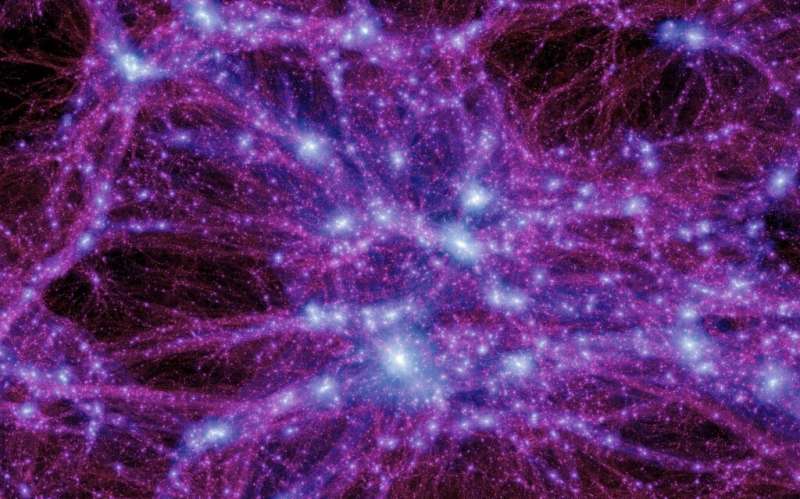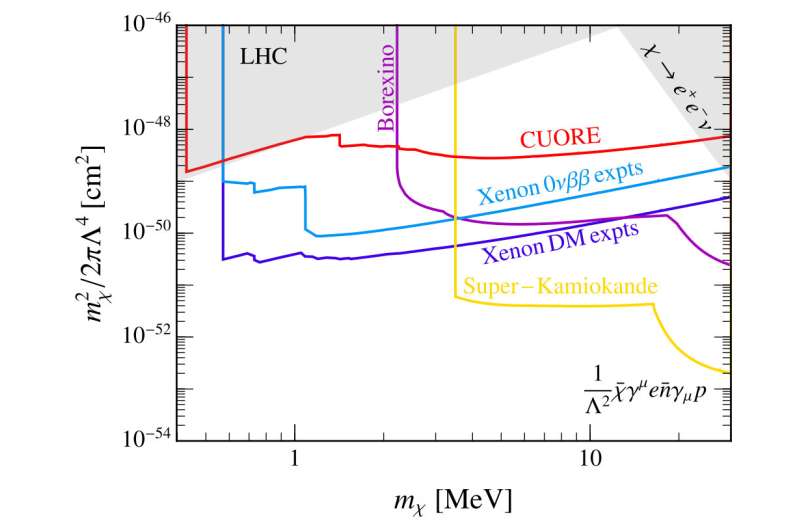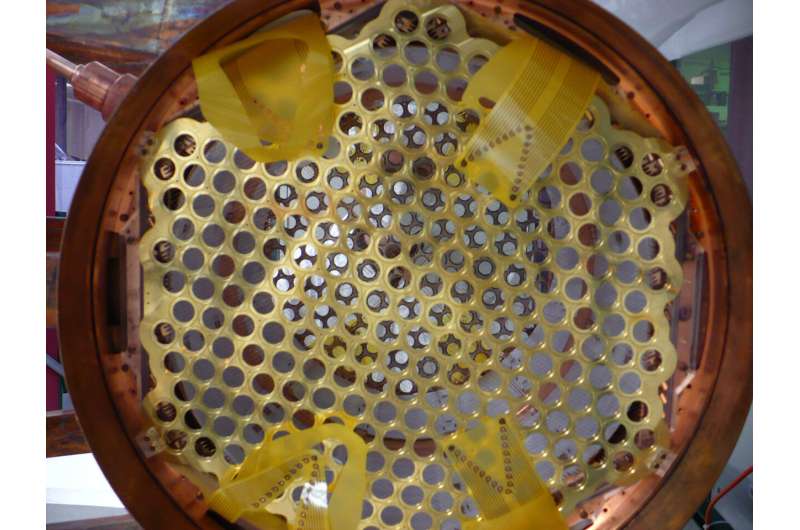Study: Could dark matter be hiding in existing data?

Dark matter has so far defied every type of detector designed to find it. Because of its huge gravitational footprint in space, we know dark matter must make up about 85 percent of the total mass of the universe, but we don't yet know what it's made of.
Several large experiments that hunt for dark matter have searched for signs of dark matter particles knocking into atomic nuclei via a process known as scattering, which can produce tiny flashes of light and other signals in these interactions.
Now a new study, led by researchers at the Department of Energy's Lawrence Berkeley National Laboratory (Berkeley Lab) and UC Berkeley, suggests new paths for catching the signals of dark matter particles that have their energy absorbed by these nuclei.
The absorption process could give an affected atom a kick that causes it to eject a lighter, energized particle such as an electron, and it might produce other types of signals, too, depending on the nature of the dark matter particle.
The study focuses mostly on those cases where an electron or neutrino is ejected as the dark matter particle strikes an atom's nucleus.
Published May 4 in Physical Review Letters, the study proposes that some existing experiments, including ones that search for dark matter particles and processes related to neutrinos—ghostly, detectable particles that can pass through most matter and have the ability to change into different forms—can easily be broadened to also look for these absorption-related types of telltale dark matter signals.

Also, the researchers propose that new searches in previously collected particle detector data could possibly turn up these overlooked dark matter signals.
"In this field, we've had a certain idea in mind about well-motivated candidates for dark matter, such as the WIMP," or weakly interacting massive particle, said Jeff Dror, the lead author of the study who is a postdoctoral researcher in Berkeley Lab's Theory Group and UC Berkeley's Berkeley Center for Theoretical Physics.
Dark matter pushes at the boundaries of the known fundamental laws of physics, encapsulated in the Standard Model of particle physics, and "The WIMP paradigm is very easy to build into the Standard Model, but we haven't found it for a long time," Dror noted.
So, physicists are now considering other places that dark matter particles may be hiding, and other particle possibilities such as theorized "sterile neutrinos" that could also be brought into the family of particles known as fermions—which includes electrons, protons, and neutrinos.
"It's easy, with small modifications to the WIMP paradigm, to accommodate a whole different type of signal," Dror said. "You can make a huge amount of progress with very little cost if you step back a little bit in the way we've been thinking about dark matter."
Robert McGehee, a UC Berkeley graduate student, and Gilly Elor of the University of Washington were study co-authors.

The researchers note that the range of new signals they are focusing on opens up an "ocean" of dark matter particle possibilities: namely as-yet-undiscovered fermions with masses lighter than the typical range considered for WIMPs. They could be close cousins of sterile neutrinos, for example.
The study team considered absorption processes known as "neutral current," in which nuclei in the detector material recoil, or get jolted by their collision with dark matter particles, producing distinct energy signatures that can be picked up by the detector; and also those known as "charged current," which can produce multiple signals as a dark matter particle strikes a nucleus, causing a recoil and the ejection of an electron.
The charge current process can also involve nuclear decay, in which other particles are ejected from a nucleus as a sort of domino effect triggered by the dark matter absorption.
Looking for the study's suggested signatures of both the neutral current and charge current processes could open up "orders of magnitude of unexplored parameter space," the researchers note. They focus on energy signals in the MeV, which means millions of electron volts. An electron volt is a measure of energy that physicists use to describe the masses of particles. Meanwhile, typical WIMP searches are now sensitive to particle interactions with energies in the keV range, or thousands of electron volts.
For the various particle interactions the researchers explored in the study, "You can predict what is the energy spectrum of the particle coming out or the nucleon that's getting the 'kick,'" Dror said. Nucleon refers to the positively charged proton or uncharged neutron that resides in an atom's nucleus and that could absorb energy when struck by a dark matter particle. These absorption signals could possibly be more common than the other types of signals that dark matter detectors are typically designed to find, he added—we just don't know yet.
Experiments that have large volumes of detector material, with high sensitivity and very low background "noise," or unwanted interference from other types of particle signals, are particularly suited for this expanded search for different types of dark matter signals, Dror said.

LUX-ZEPLIN (LZ), for example, an ultrasensitive Berkeley Lab-led dark matter search project under construction in a former South Dakota mine, is a possible candidate as it will use about 10 metric tons of liquid xenon as its detector medium and is designed to be heavily shielded from other types of particle noise.
Already, the team of researchers participating in the study has worked with the team operating the Enriched Xenon Observatory (EXO), an underground experiment searching for a theorized process known as neutrino-less double beta decay using liquid xenon, to open up its search to these other types of dark matter signals.
And for similar types of experiments that are up and running, "The data is already basically sitting there. It's just a matter of looking at it," Dror said.
The researchers name a laundry list of candidate experiments around the world that could have relevant data and search capabilities that could be used to find their target signals, including: CUORE, LZ predecessor LUX, PandaX-II, XENON1T, KamLAND-Zen, SuperKamiokande, CDMS-II, DarkSide-50, and Borexino among them.
As a next step, the research team is hoping to work with experiment collaborations to analyze existing data, and to find out whether search parameters of active experiments can be adjusted to search for other signals.
"I think the community is starting to become fairly aware of this," Dror said, adding, "One of the biggest questions in the field is the nature of dark matter. We don't know what it is made out of, but answering these questions could be within our reach in the near future. For me, that's a huge motivation to keep pushing—there is new physics out there."
More information: Jeff A. Dror et al. Directly Detecting Signals from Absorption of Fermionic Dark Matter, Physical Review Letters (2020). DOI: 10.1103/PhysRevLett.124.181301
Journal information: Physical Review Letters




















